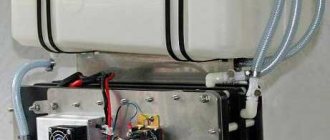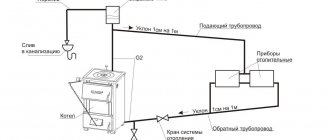How to save gas Useful tips
Obviously, if gas consumption meters are not installed in the apartment, then saving gas makes no sense. In the past, when gas cost a penny, and no one even thought about metering devices, with poor centralized heating, they heated the living space using a gas stove.
Today everything has changed. Gas costs money, and its value is constantly growing. In order to pay not at the general tariff, but only for what is consumed, many install gas meters. Then they immediately start saving. In this life hack we will tell you how to save gas in an apartment with a meter.
How to save gas when cooking
Here are some tips on how to save gas when cooking. By following them, you can reduce your stove's gas consumption by 30%.
Use the correct cooking utensils
Throw away all your old pans. They were created for use in an era when gas was plentiful and cheap. Buy 1-2 pots with energy-saving properties. We don’t know exactly how manufacturers achieve this effect, but these pans have amazing properties:
they actually require less gas while maintaining high efficiency
the contents of such a pan boil faster
To maintain boiling at the desired level, the minimum heat is required
Yes, energy-saving pans are more expensive than regular ones. But since this is a long-term item, sooner or later it will pay for itself, and you will start saving gas immediately. In addition, new and modern kitchen utensils are always pleasant and joyful.
Reduce cooking time
Practice shows that people traditionally unjustifiably increase the cooking time on the stove. This is especially true for vegetable dishes. You can often see in recipes and recommendations that, for example, celery root needs to be cooked until tender for 15-20 minutes. Although in reality 5 minutes is enough.
Accustom yourself to the fact that the less you cook vegetables, the healthier and tastier the dish will be. For example, to cook broccoli you need no more than 5 minutes in boiling water. Despite this, many people can cook broccoli soup for 30 minutes.
You can't do it with meat in five minutes. But even in this case, the cooking time can be reduced. To do this, cut the meat into small pieces. For example, a large piece of beef needs to be cooked for 1.5-2 hours. By forming small pieces, you will reduce the time to 30-40 minutes.
Some foods do not need to be boiled
Do you know what our great-great-grandmothers did with buckwheat porridge in the days when they cooked in ovens? They poured water over the cereal, brought it to a boil, after which they tightly “wrapped” the pan or cast iron with a blanket and left it for 1 hour.
Within an hour, the porridge absorbed all the water and became boiled and tasty. Result: instead of 30 minutes of cooking, bring to a boil for 10 minutes. Yes, it will take more time for the porridge to “arrive”, but if you are not in a hurry, then the gas savings are obvious.
This strategy works not only with buckwheat, but also with all other cereals, porridges, and vegetables.
Maintain an average level of gas supply to the burners
We often do not know what to do, including when we use a gas stove. Most of us, out of habit, open the gas burner to full power. Paradoxically, this approach not only does not speed up heating, but in many cases reduces the efficiency of a gas stove and increases costs.
The fact is that the maximum flame temperature is reached at its periphery. When we turn on the gas too much, the flames seem to “grasp” the bottom of the pan, or at least fall almost along the diameter of the bottom. This leads to the fact that part of the energy goes bypassing the dishes and is dissipated. As a result, we spend more gas than required.
Individual heating of water for domestic use is not a bad idea in the age of centralized hot water supply. In this case, you pay only for the volume of heated water that you used; you do not heat the air and ground around heating mains, basements and reinforced concrete floors with this heat. Unfortunately, there are only two options to save gas by using a gas water heater.
You should install a water heater that turns on the gas supply (and, accordingly, heats the water) only when it is in use. Such devices are equipped with electric ignition, which is activated as soon as water begins to flow through the unit. Compared to non-flowing columns, such devices can save up to 50% of gas.
Basic home heating methods
If you are thinking about how best to heat a house without gas, we recommend turning to electricity, which is the easiest way to organize heating.
If we talk about profitability, then electricity is at the very bottom of the ranking. Diesel can be used as fuel for such devices, which is also quite expensive. Thus, 1 Gcal of heat will cost 3,500 rubles. In this case, you will have to deal with the unpleasant odor that will form near the heating unit. Despite its shortcomings, diesel fuel is becoming an affordable alternative fuel for many consumers.
You can also heat your home using coal, which is a cheap fuel. With it, heating will cost four times less compared to the method described above. Thus, for 1 Gcal of heat you will have to pay one thousand rubles.
If you are faced with the question of how to heat a house in winter without gas, then you can use peat, which comes in the form of briquettes. It will cost about one and a half times more than coal.
The most common option for heating a house is to use firewood, which costs little, but it is not always convenient to use, but it will burn out much faster than coal.
For appliances installed in the house, you can use pellets; they are granules created from wood waste. You can get 1 Gcal of heat by paying 1,500 rubles. Moreover, this type of fuel is very convenient to use for boilers in which fuel can be supplied automatically.
Meter installation
Gas metering devices can not only completely control gas consumption, but also make it possible to save money. In addition, paying according to meter readings is much easier.
Two types of gas control devices are installed in apartments: rotary and electronic. If there is only a water heater or gas stove in the living room, small meters are used. Volumetric appliances are installed when connecting autonomous gas heating.
According to calculations, the use of meters for individual control of gas consumption can reduce payments by 30 percent, in contrast to charges based on consumption standards. Moreover, the installation of the device fully pays for itself in less than two months.
When using a meter, no additional permission is required to start autonomous equipment for heating the house. You can especially save money with a natural fuel meter if you have a gas water heater.
Installation of gas meters is carried out after approval of the project documentation in which the device is specified. You can purchase the meter yourself, but installing it yourself is prohibited. All installation work is carried out only by gas service specialists, who, after completion of the work, provide full instructions on the safety of using the device.
A seal is installed on the device to protect the accounting mechanism from unwanted opening. Any mechanical intervention to correct gas readings does not lead to savings, but incurs higher costs in the form of fines.
Saving gas in residential premises must be done competently and legally. Costs can be reduced with the correct approach to using all gas equipment installed in the house. By following simple tips, you can easily reduce natural fuel consumption and save more than 30 percent of your money.
How to save gas when heating a private home with gas
How to save gas in a private home?
So, how can you save gas when heating your home with gas?
The main item of energy expenditure in a private household with a gas heating boiler falls on the heating system, so special attention should be paid to saving “blue fuel” in this direction. There are several quite accessible ways to reduce gas consumption, which are presented:
There are several quite accessible ways to reduce gas consumption, which are presented:
- Insulation of private households. External walls, in this case, need to be insulated using slab materials such as mineral wool or polystyrene foam. The standard thickness of a layer of such insulation can vary between 6.0-10 cm. This insulation option allows you to save the usable area of the internal space. The basement and attic spaces must be insulated.
- Installation of energy-saving metal-plastic or wooden double-glazed windows, as well as replacing doors with more modern models that retain heat well in the room. If it is not possible to purchase new structures, high-quality insulation of old windows and doors with any heat-saving materials, including foam rubber and mineral wool, is allowed.
- Regulating the ventilation mode. Maximum efficiency is achieved by fully opening the windows for a few minutes, rather than a prolonged supply of outside air through a slightly open window. At the same time, there is a significant renewal of indoor air with minimal losses of thermal energy.
- Insulation of a heating boiler, boiler or expansion tank located in unheated or poorly heated rooms.
Experts also recommend installing a programmer that allows you to reduce power levels and, accordingly, gas consumption in the absence of residents in the room.
Very high efficiency is shown by supplementing the standard gas heating system of a private house with wood fireplaces or solid fuel stoves, which make it possible to provide the room with a comfortable temperature regime with minimal fuel consumption.
Saving gas in a private home for heating
An increased temperature regime in a house relative to street indicators is possible only if there is a noticeable difference between the amount of thermal energy produced by the heating system and the total volume of heat losses.
To significantly reduce the cost of paying for gas heating and hot water, you can use various methods, including automation of the operating heating equipment and regulation of the operating mode of the ventilation system.
Savings through ventilation
High-quality ventilation, when properly arranged, helps maintain optimal temperature in the room.
When installing exhaust ventilation pipes in houses heated by gas equipment, the following basic rules must be observed.
Namely:
- the pipe is installed in a certain position;
- the pipe height indicators should not allow carbon monoxide to enter the room, both through windows and doors during ventilation;
- a special device installed to protect ventilation from dirt and precipitation should not interfere with the full outflow of combustion products.
The size and shape of the ventilation device varies. The chimney pipe can be fixed to floor and wall equipment. The dimensions of the pipe must be determined in accordance with the power ratings of the heating equipment and the diameter of the outlet pipeline opening.
The pipe for the influx of street air masses must have a sufficiently wide hole, the diameter of which always depends on the power level of the gas equipment and is approximately 0.8 cm2 for every 1 kW.
Conclusion
Savings of “blue fuel” with proper arrangement of gas heating and hot water supply systems often reaches 20-25%.
For this purpose, experts recommend purchasing convenient room thermostats with a programmer function or the most modern weather-dependent sensors, as well as using economical alternative additional sources of heat energy generation.
How to save gas: a few words about scams and scams
The first thing you come across on the Internet when you search for how to save gas using a meter is a unique device called GAS SAVER - a real miracle of technology that allows you to reduce gas consumption. Enthusiastic reviews from grateful customers, promotions and discounts on the purchase of several of these devices - in general, everything so that a person does not pass by and buy the treasured device to save gas. Many people buy, thereby enriching the sellers, and many treat it with caution, realizing that miracles do not happen in the world.
Let's not beat around the bush, but let's say frankly - a device for saving gas in a private home is nothing more than a useless magnet. By and large, it can only be used as a holder for small metal rubbish and nothing more. The gas can be structured, as the sellers explain the principle of operation of the device, only by creating a very strong magnetic field of enormous intensity - neodymium magnets are not capable of this. This requires a large industrial installation. Even if you install it, the energy costs will be unjustified.
In general, there is no need to rush to buy a miracle device - at least first you need to ask about its capabilities from happy friends who have already managed to purchase it and throw it in their hearts on the farthest shelf in the pantry.
Ways to save gas in the kitchen
Plan based on your needs
It’s clear that a spacious kitchen is the dream of any housewife. However, think about whether you really need a built-in gas oven or grill that will be turned on several times a year? The fewer “bells and whistles” you have, the less consumption, and not only of gas, but also of your time to care for all this goodness. A compact but functional kitchen is the first step to saving gas.
Kettle or thermopot, what to choose
Keep burners clean
Clean burners regularly to remove grease and soot. The cleaner they are, the less gas will be required to achieve the required temperature.
Pay attention to the color of the flame, it should be blue. If red or orange “notes” appear, it’s time to clean the burners
If the color has not changed, it means that you are being supplied with low-quality gas, poorly purified from impurities.
Use quality cookware
Listen to your wife and finally buy normal pots and pans. Perhaps she wants new ones for purely aesthetic reasons, but this is one of the ways to save gas at home. The material of the cookware and its thermal conductivity play a significant role in the increased consumption.
Choose pots by size
Before you and your happy wife go shopping for new pans, measure the diameter of the burners. The same principle applies here as when using an electric stove economically. The cookware should be the same size, or slightly larger than the burners. If it is less, a significant part of the gas does not fall to the bottom, but “licks” the sides, leading to senseless overspending
It is also important that the bottom of the pans is perfectly flat.
Make your pots sparkle
Clean pots can not only please the eye, but also save gas. Their shiny surface conducts heat better than one contaminated with soot.
Do you need a dishwasher in your home?
Use lids
A simple way to save gas is to cover your cookware with a lid as often as possible while cooking. Firstly, this measure will allow the dish to heat up faster, using less energy. Secondly, minimizing the access of oxygen gives food an additional, richer taste. For the same reasons, you should not pour in excess water.
Buy a pressure cooker
Modern pressure cookers bear little resemblance to the monsters we first saw 20-30 years ago. Today it is a high-tech device that looks not much different from an ordinary saucepan. But to prepare the same dish, it consumes almost half as much gas. An additional bonus is saving time and minimal loss of beneficial properties of food.
Follow the flame
It is a well-known fact that the maximum temperature is reached at the very tip of the flame. Therefore, opening the gas “all the way” is justified only when using pots with a large diameter, and even then not always. Try to adjust the flame immediately after turning on the stove so that it “rests” at the bottom with its top, and not the middle. After the water boils and as the food cooks, keep the flame at the required minimum.
Cook in large batches
Preparing meals for several days at once is an easy way to save gas and time. After all, heating food requires significantly less energy than cooking it.
Close the oven tightly
If you have a gas oven, make sure that its door closes tightly and does not let out heat. This will save you from pointless expenses.
As you can see, saving gas at home is not such a difficult task. Using these simple tips, you can reduce your consumption by 15-20%.
Saving gas at home, the most effective methods
The presence of gas in everyday life is a very great benefit; with proper use of the equipment, this energy carrier is much more economical than electricity. To reduce gas consumption, you should pay attention to the following points:
- Sealing and sealing of windows and joints between the window sill and the window frame. Silicone sealant is the most suitable thing for this. It would be correct to install a vestibule second door.
- Controlling the temperature level in the rooms. If no one lives in the room, you can limit the flow of hot water into the battery using a special valve. This only applies to new heating radiators.
- Using a gas water heater in an inoperative state with an active burner can lead to the loss of up to a cubic meter of fuel per day.
- Disabling the hood. When it works, a zone of rarefied air is created in the kitchen. In this case, cold air will flow through the cracks in the windows.
- Debugging the operation of a gas boiler - coolant temperature, on and off times.
- Setting the recirculation of warm water in the hot water supply system during the daytime when there is flow, the rest of the time it should be turned off.
- In cold rooms, place a rug or thick carpet on the floor.
When replacing gas equipment, you must pay attention to its efficiency and level of efficiency.
You should not buy a boiler whose power will be excessive for a particular apartment or house. In such cases, you need to consult not so much with salespeople in household appliance stores, but with specialists.
How to save gas
Gas meter installation
If in apartments gas is most often used for kitchen stoves and heating water in boilers, then in private houses the heating system runs on gas. First, you need to install a meter that will count how much gas you have spent, because it is better to pay for the actual cubic meters consumed. After all, despite the fact that installing a meter is not a particularly cheap undertaking, it is better to pay for the gas that you actually used than what the local gas organization calculated for you.
Moreover, installing a gas meter is also beneficial in apartments, and not just in private houses. By paying for the installation of a meter, we can be sure that we are paying for the gas consumed, and not paying for the cubic meters that Gorgaz calculates based on average consumption. This is especially true when hot water is turned off and utility companies send bills that contain the clause: “For heating water during a hot water supply outage.” Those who have an electric water heater installed are very happy about such payments; they heat the water themselves, but still have to pay more for gas than necessary.
Modernizing your home
In order not to heat the street during the cold season and spend much less gas, it is more practical to insulate the walls of the house, which will make the home both more comfortable and more energy efficient. It is better to spend money on insulation than to pay exorbitant amounts for gas every year. Insulated houses require significantly less fuel, and this allows you to save gas at home
, since in winter the rooms become warmer, and in summer living quarters do not require as much cooled air from the air conditioner and double savings are obtained - gas in winter and electricity in summer.
The heating system in a private home, which consumes most of the gas, can be modernized, which will reduce the cost of gas consumed. Install a pump on the gas boiler that will circulate the heated coolant through the system. Install thermal heads on the heating radiators, and attach foil screens between the radiator and the wall, which will reflect heat into the room and not heat the walls of the house. Try not to cover heating radiators with thick curtains, drapes, furniture and various decorative screens that prevent heat from spreading freely throughout the room.
Installation of a gas meter
First of all, you need to install a meter. This will allow you to pay only for the volume of gas that was consumed. Paying according to the general tariff cannot save money, since you have to pay monthly based on average data.
How to make the right choice of gas meter
There are several types of counters:
- rotary;
- membrane;
- turbine.
When choosing any of these types of devices, you need to pay attention to some characteristics:
- throughput;
- presence of thermal corrector;
- date of manufacture of the device;
- installation location.
If specialists will help you cope with the first two tasks, then the owner should pay attention to the date of manufacture of the meter and the installation location. When buying a device, you must choose the one whose manufacturing date is as close as possible to the date of sale. If the meter is stored in a warehouse or store, the interval between gas service checks will be significantly shorter.
In a private house, it is better to install the device outdoors. But on the condition that it must be carefully protected from environmental influences. For this purpose, special metal cabinets are installed. For an apartment, it is better to purchase a low-noise model. The installation location must be selected taking into account all requirements. Meters with a thermal corrector are not suitable for apartments; this should also be taken into account before purchasing.
In any case, before installing a gas meter, it is better to consult with a specialist who can suggest the optimal model of the device, its type and installation location.
In this article we will look at the following ways to save gas
How to save gas for heating, what equipment to use.
Thermoregulation by thermostat
Weather-dependent sensors, thermostats
More efficient equipment.
Condensing gas boilers.
Saving gas for cooking
Gas substitution
Solar energy for home
Special roof and wall coverings.
Heat pumps for heating
Heating by air conditioner
When it comes to saving gas
, the first thing that comes to mind is insulation of a house or apartment. And it is right. A warm house is not only much more economical, but also takes care of the health of its inhabitants. The absence of drafts and a comfortable temperature will protect your family members from illness, and gas savings will be maximum.
| From the author: In 2012, I insulated my house in the village of Oseshchina (Vyshgorod district, Kiev region). External insulation with 10 cm of glass wool + siding, insulation of the floor 10 cm and attic 15 cm cost me approximately 35 thousand UAH (house 8x8, 2 floors). If before insulation I spent 3800-4200 UAH annually on heating, then in the winter of 2012-13 I spent only 2200 UAH. |
You will find more information about home insulation in this article.
Analysis of heat losses and ways to reduce them
In a private house, the greatest amount of heat is lost through windows, walls and roof. In addition, a certain amount of thermal energy is lost with the escaping air through the ventilation system, because warm air is replaced by cold outside air. Therefore, the following ways to save on heating are:
Firstly, insulating the roof or attic - using stone wool, foamed polymers, covering the roof with sandwich panels. In each specific case, the choice is made based on the characteristics of building structures and the solvency of the owner.
Secondly, reducing heat loss through windows. There are two acceptable methods here. The first is to reduce the total window area of the entire house, but at the same time reducing the amount of sunlight entering the premises. The second way is to install windows with better energy performance. These are windows with double and triple glazing, multi-circuit window systems and special windows, the glass of which is coated on one side with a thin layer that reflects infrared radiation.
Thirdly, insulating the walls of the house or constructing them from materials with better thermal characteristics.
How to save gas on the meter
The fact that you installed a gas meter will already save you money, because you will only pay for the gas you consume. But every person wants to save as much as possible on utilities so that they can then spend these savings on themselves. There are several methods on how to legally save gas using the meter:
- Be sure to turn off appliances you are not using;
- Use as much gas as needed;
- Take advantage of every opportunity to save gas;
- If you use a gas water heater, save hot water;
- Use special dishes for a gas oven.
First, you must understand that cooking gas should only heat the bottom of the cookware, not the walls. In this case, only the gas flow increases, and not the heating temperature.
There are several simple tricks to save money on your gas meter. You can place foil on the surface of the oven, this will help reflect the heat and reduce cooking time.
If possible, use special dishes for gas stoves, they have grooves on them, then the dish will be able to cook itself when the gas is turned off. A kettle with a whistle will prevent you from using gas for an extra minute.
If your home has a gas water heater, try to take a shower rather than a bath, turn off the water when washing and brushing your teeth, and install economical shower dividers. When you wash dishes, lather them first, and then turn on the rinse water.
Thermostat devices for gas saving
If you want to save as rationally as possible, then you should buy a thermostat device to save resources. Such a system will help save a decent amount of money on gas payments. The saved money can be spent on necessary purposes.
What is such a device?
A thermostat device for saving gas is a wall-mounted control panel with a display and a set of functions, thanks to which you can use the resource rationally and economically.
An example of a thermostat installed on the wall to save gas consumption
Using the device is quite easy. Even a person who has not previously encountered such equipment will master the skills of using it.
Installation of the product is quite simple. However, it is better to contact a professional for installation. This will help avoid system malfunction and gas supply problems.
Principle of operation
Before installing a gas saving device, you need to understand what its functions are and what gas-related processes it will help with. First of all, such a device should be emphasized by people who have gas boilers installed in their homes.
The device is directly connected to the boiler, which ensures their complete interaction. A rational solution would be to place the control panel close to the boiler. This will help improve functionality and speed up the process of responding to specified parameters.
Watch the video: the operating principle of a programmable room thermostat.
The owners of the house or apartment will immediately notice significant gas savings when heating. It is clear that the boiler is turned on to heat the room or water. With the help of the device, the automatic shutdown function is set on the display when the space is heated to a certain temperature.
Comfortable temperature
First, let's decide what temperature needs to be maintained in the house to make it comfortable to live in. Experts believe that the norm is approximately 25 degrees Celsius.
In this mode, heating systems consume one hundred percent of gas. How to reduce this norm?
It is believed that we do not have many ways to save gas. One option is to lower the temperature. If you lower the bar to 17 degrees Celsius, the heating system will consume only 68 percent of gas.
The savings are significant, but the temperature is uncomfortable for living. If we take into account that a maximum temperature of 25 degrees Celsius is not needed all the time, then this fact can already be used. For example, you can reduce the temperature in the house to 17 degrees Celsius at night and during the day when no one is home
. This will allow 78 percent of gas to be consumed.
Since the heating system will be running at full power most of the time on weekends, only 81 percent of the gas will be consumed on average during the week
. Depending on gas tariffs, residents will be able to save more than a thousand rubles in a year.
Saving gas in a private home: method one - insulating the house
There is only one real way to reduce gas consumption - reduce its consumption. For most people, this involves lowering the comfortable temperature in the home and nothing more, but there are ways to save gas that allow you to keep the comfort in your home at the same level. All that needs to be done for this is simply to retain heat - as the builders say, to reduce heat loss to the maximum possible level. To put it even more simply, you need to insulate the house. When the heat lingers in the rooms, willy-nilly you will have to turn on the heating boiler tap - otherwise it will become hot, which is not at all comfortable.
Insulating a house is a very expensive, but effective task. It is a set of measures that provides for comprehensive thermal insulation of the house.
1.First of all, these are the walls. The easiest way to insulate them is: the most basic thing is to cover the outside walls of the house with foam plastic. Alternatively, you can create a false wall indoors and lay mineral wool behind it.
2. Ceiling - most of the heat leaves the house through it. The ceiling in a private house from the attic side is insulated with the same mineral wool or polystyrene foam.
3.Gender The principle is the same - insulation is laid under the screed or wooden flooring.
4.Windows and doors. It is better to replace old wooden products of this type with new metal-plastic ones, equipped with energy-saving double-glazed windows.
In general, there will be a lot of work, but this, as they say, is just the beginning. Insulation is good, but along with it, other methods are also used to achieve greater savings.
New ways to profitably heat your home
One of them is convector heating, due to oil-type heaters and radiators, the second is an innovation, infrared heating, or PLEN.
Infrequently used, but also cheap, home heating is considered: heat pumps and solar heating. Solar energy has long been used in Western countries, but in Russia this method is still difficult to take root. The fact is that solar panels are quite expensive, but if you purchase a battery and a heating tank, connected two in one, you can get an excellent alternative source of heat.
Any cheap heating of a private home has been greatly appreciated lately, since maintaining any home is becoming very expensive. However, in a private house there is an opportunity to save money, because there you will not need housing and communal services, and you will decide for yourself when to turn on the heat, when to turn it off, and in what ways to heat it in the heating pipes.
Room adjustment
Not all rooms need to be heated equally. There is no need to maintain the same temperature in rooms for different purposes. Those requiring increased gas costs include:
- bedrooms and children's rooms;
- showers and bathrooms, toilets;
- living rooms and offices.
Non-residential rooms will require less heating:
- storerooms and warehouses;
- sports or gyms;
- garage premises;
- working workshops.
Regulators are installed separately for each radiator. These are small devices. Their task is to reduce or increase the flow of coolant into the battery. Or completely blocking the supply. There are several types of thermostats. Each of them works according to a special principle and has advantages and disadvantages.
- Mechanical . They involve manual adjustment of the coolant volume. The main advantage of mechanical regulators is the low price and simplicity of the device. The degree of heat transfer from the radiator is adjusted manually. You can independently determine the amount of coolant entering the battery.
- Electronic . Readings are taken from remote sensors. The device is based on a programmable microprocessor. There are control buttons on the regulator. With their help, the desired temperature is set. Some models of electronic regulators can control both the pump and the mixer. There are two types of electronic temperature sensors:
- Mechanical thermal heads. This is a valve that at a certain moment compresses a special liquid. It expands when heated and shrinks when cooled. The adjustment error remains.
Installing thermostats allows you to optimize gas consumption by selecting the water heating mode in the boiler. In each room you can create comfortable conditions. At the same time, you will save from 5 to 10% of the money you pay for gas.











